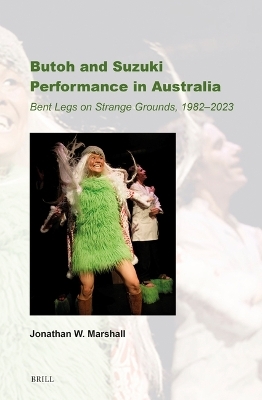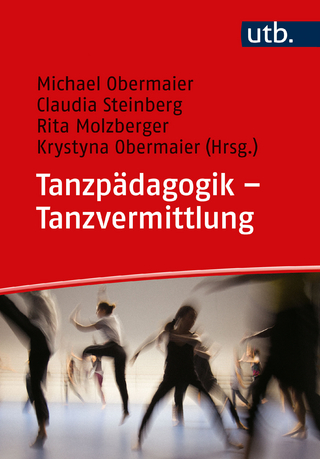
Butoh and Suzuki Performance in Australia
Brill (Verlag)
978-90-04-71230-0 (ISBN)
- Noch nicht erschienen (ca. Januar 2025)
- Versandkostenfrei innerhalb Deutschlands
- Auch auf Rechnung
- Verfügbarkeit in der Filiale vor Ort prüfen
- Artikel merken
In Butoh and Suzuki Performance in Australia: Bent Legs on Strange Grounds, 1982-2023, Marshall considers how the originally Japanese forms of butoh dance and Suzuki’s theatre reconfigure historical lineages to find ancient yet transcultural ancestors within Australia and beyond. Marshall argues that artists working in Australia with butoh and Suzuki techniques develop conflicted yet compelling diasporic, multicultural, spiritually and corporeally compelling interpretations of theatrical practice. Marshall puts at the centre of butoh historiography the work of Tess de Quincey, Yumi Umiumare, Tony Yap, Lynne Bradley, Simon Woods, Frances Barbe, and Australian Suzuki practitioners Jacqui Carroll and John Nobbs.
Jonathan W. Marshall’s Bent Legs on Strange Grounds is an important contribution to the body of literature on butoh, as well as to studies of dance in Australia that will be valuable to practitioners and scholars alike. Detailed discussions of Australian butoh artists open up consideration of how global and local histories, migrations, and landscapes not only were key to butoh’s formation in Japan, but also to its continued development around the world. Attention to butoh’s emplacement in Australia, Marshall convincingly argues, reveals insights about national identity, race, power, and more that are relevant well beyond the Australian performance context.
— Rosemary Candelario, Texas Woman’s University, co-editor, Routledge Companion to Butoh Performance (2018)
Marshall’s Bent Legs on Strange Grounds explores the remarkable transformative era of Australia’s reconsideration of its place in the region. A definitive study of Australian experiments in butoh and the theatrical vision of Suzuki Tadashi, the book shows how new corporeal and spatial dramaturgies of the Japanese avant-garde fundamentally changed Australian performance. Expansively researched and annotated, this impressive study connects Australian performance after the New Wave with globalization, postmodern dance, Indigeneity, and subcultures, and it details the work of leading Australian/Asian artists. Bent Legs on Strange Grounds speaks about the development of embodied knowledge and the consequential refiguration of Australia’s sense of being in the world. It is also a study of butoh and Suzuki’s legacy in global terms, wherein Australian experimental performance also becomes something larger than itself.
— Peter Eckersall, The Graduate Center, CUNY, author of Performativity and Event in 1960s Japan (2013).
Jonathan W. Marshall has written about butoh and Suzuki since 1995, and published extensively on the relationship between the hysteria diagnosis and performance. He is associate professor and postgraduate coordinator, Western Australian Academy of Performing Arts, Edith Cowan Australia. https://edithcowan.academia.edu/JonathanWMarshall
Acknowlegements
List of Figures
1 Bodies Possessed by History: an Introduction to Butoh and Suzuki
1 Introduction
2 Butoh, Suzuki and the Move to Australia
3 Primal Scenes of Butoh Encounter
4 What is Butoh?
5 Suzuki Technique and the Way of Stomping
6 Lineages of Descent Ancient and Modern in Butoh and Suzuki
7 Butoh and Suzuki Technique in Other National Contexts
8 Criticism and Reception of Japanese Performance in Australia
9 Emptiness and Possession
10 Primary Sources and Thick Description
11 Overview and Book Structure
2 Butoh and the Australian Context: Dancing the Landscape While Dancing Global Relations
1 Introduction
2 Consolidation in Japan and Movement to Australia
3 Tanaka’s “Map of History through Dancing” in the Contested Lands
of Australia
4 Corpus Nullius: Moving beyond the Emptiness of the Butoh Body
5 Expressive Japanese Performance as a Counter to the Postmodern “Performance of Absence”
6 Bodies in Opposition to the Australian Legend: Butoh, Suzuki and Grotowski
7 Troubled Relations between Australia and Asia Prior to the Japan Theatre Boom
8 The Japanese Theatrical Boom in Australia, 1982–1994
3 De Quincey Takes Body Weather Inland: Lake Mungo and Alice Springs
1 Introduction
2 De Quincey’s Butoh Encounter and Position Within Australian Dance
3 Tanaka Min and Body Weather
4 De Quincey’s Development from Postwar Britain to Australia
5 De Quincey’s First Solos in Australia
6 Body Weather as an Uncanny Project: Tracing an “Interactive History of the Senses” on Australia’s Colonised Lands
7 De Quincey’s Lake Mungo Workshops, 1991–92, and beyond
8 Lake Mungo Performance Works and on to Alice Springs
9 Triple Alice, 1999–2001
10 Triple Alice Performances and Dictionary of Atmospheres (2005)
4 Body Weather Comes Back from the Desert:
De Quincey’s Urban Works, the Hysterical Body, and Other Body Weather Performers in Australia
1 Introduction
2 De Quincey’s Urban and Industrial Site-Specific Works: Compression 100 (1996), City to City (2000), The Stirring (2007), Run (2009)
3 A Masterpiece of Hysterio-Choreography: Nerve 9 (2001–05)
4 Other Bodyweather Artists in Australia
5 Heywood and Humanimal Body Weather
6 European Tanztheater Meets Australian Body Weather:
Martin Del Amo
7 Post-Colonial Butoh and Rejecting the Empty Body: Gretel Taylor
8 Evidence of Bodily Emergences
9 Fragmented and Dialectical Bodies
5 Diasporic Austral-Asian Fusions 1: Early Works by Umiumare
and Yap
1 Introduction
2 Umiumare’s and Yap’s Butoh Encounters
3 Umiumare and Yap within the Context Butoh
4 Maro and Dairakudakan
5 Umiumare: From Regional Japan to Urban Australia
5 Tony Ding Chai Yap: From Melakan Trance to Australian Physical Theatre
6 Theatre of Sacrifice and Redemption: Yap in IRAA, 1988–94
7 Mixed Company and Tony Yap Company, 1993-Present
8 Umiumare and Yap in Love Suicides (1998), Miss Tanaka (2001), and Meat Party (2000)
9 Kagome (1996–98)
10 Sunrise at Midnight (2001): a Sequel to De Quincey’s Mungo Workshops
11 Duets by Umiumare and Yap: How Could You Even Begin to Understand? (1996–2007), In-Compatibility (2003) and Zero Zero (2010–14)
12 Umiumare’s Fleeting Moments (1998)
13 Yap’s Decay of the Angel (1999)
14 Conclusion
6 Diasporic Austral-Asian Fusions 2: Yap’s Trance Dance and Umiumare’s Butoh Cabaret, Character Dances and First Nations Collaborations
1 Introduction
2 Butoh Cabaret and Hystericised Character Dances: Umiumare’s DasSHOKU Series (1999–2015) and Entrance (2009–12)
3 Umiumare’s First Nations Collaborations: Marrugeku’s Burning Daylight (2006–09) and Big Hart’s Ngapartji Ngapartji
(2007–12)
4 Yap and Trance Dance; Umiumare and Jujutsu
5 Yap’s Eulogy for the Living (2009–17), Rasa Sayang (2010), and Liminal City (2021–22)
6 A Trance Dance Masterpiece: Yap’s Animal/God: the Great
Square (2021)
7 Conclusion: Yap’s Map Fest (2008-Present) and Umiumare’s ButohOUT! (2017-Present)
7 Stomping Downunder: Suzuki and Frank Theatre
1 Introduction
2 Carroll’s and Nobbs’ Encounters with Suzuki
3 Suzuki Tadashi in Japan and Australia
4 The Australian Production of Chronicle of Macbeth (1992)
5 Foundation of Frank Theatre
6 Larrikin Orientalism: Frank Theatre’s Early Works
7 Universalism, Localism and Racial Hierarchies
8 Nobbs Suzuki Praxis (NSP)
9 Butoh Incursions, the Hysterical Body, and Emptiness
10 Frank’s Doll Seventeen (2002–03)
11 Conclusion: the Way Forward is Mixed
8 Butoh in the Southern Tropics: Zen Zen Zo and Associates
1 Introduction
2 Bradley’s and Woods’ Encounters with Japanese Performance
3 Zen Zen Zo’s Foundation and the Development of Its Aesthetic, 1992–98
4 Zen Zen Zo’s Early Work and Brisbane Physical Theatre
5 Zen Zen Zo, Frank and Reworking Japanese Aesthetics
6 Zen Zen Zo’s Early Butoh Productions and Butoh Choruses
7 Fusing Butoh with Suzuki: Zen Zen Zo’s Cult of Dionysus
(1994–96)
8 Frances Barbe’s Tōhoku Australis
9 Butoh Diffusions
9 Conclusion: Two Closing Scenes from Australian Adaptations of Butoh and Suzuki
1 NYID S the Dispossessed (2008) and Hunt’s Copper Promises (2016)
Bibliography
Index
| Erscheint lt. Verlag | 23.1.2025 |
|---|---|
| Reihe/Serie | Australian Playwrights ; 20 |
| Verlagsort | Leiden |
| Sprache | englisch |
| Maße | 155 x 235 mm |
| Gewicht | 1 g |
| Themenwelt | Kunst / Musik / Theater ► Theater / Ballett |
| Sachbuch/Ratgeber ► Sport ► Tanzen / Tanzsport | |
| ISBN-10 | 90-04-71230-5 / 9004712305 |
| ISBN-13 | 978-90-04-71230-0 / 9789004712300 |
| Zustand | Neuware |
| Haben Sie eine Frage zum Produkt? |
aus dem Bereich


